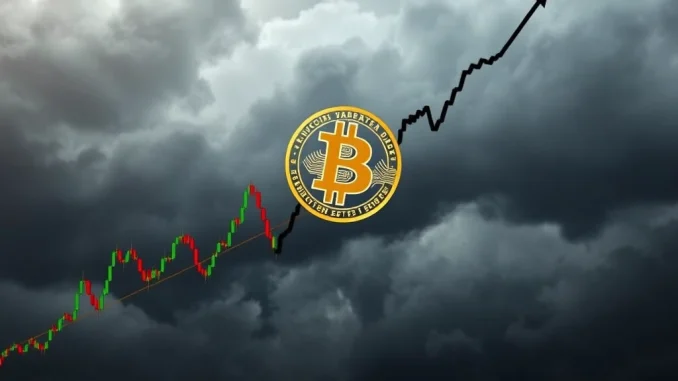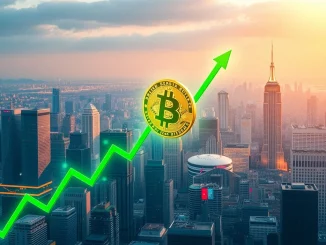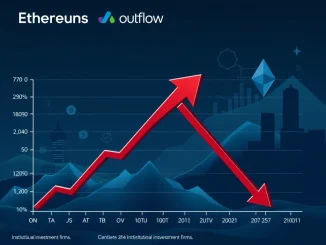
The crypto market, known for its volatility, is throwing another curveball. This time, it’s hitting closer to home for investors in Bitcoin mining ETFs. Valkyrie’s Bitcoin Mining ETF, trading under the ticker WGMI, is making headlines for all the wrong reasons. Prepare yourself as we delve into the concerning reality: WGMI is currently the worst-performing ETF of 2025, plummeting a staggering 43% year-to-date. Is this a temporary dip or a sign of deeper troubles in the Bitcoin mining sector? Let’s investigate.
Why is the Bitcoin Mining ETF WGMI Plunging? Unpacking the Dismal Performance
The sharp decline of the WGMI ETF isn’t happening in a vacuum. Several interconnected factors are contributing to this shocking downturn, creating a perfect storm for this particular investment vehicle. According to CoinDesk, the ETF’s woes are largely tied to the poor performance of its top holdings. Let’s break down the key culprits:
- Struggling Mining Giants: Companies like IREN (presumably Iris Energy), Core Scientific, and Cipher Mining, which constitute significant portions of WGMI’s portfolio, have experienced substantial losses. These are major players in the Bitcoin mining industry, and their struggles directly impact the ETF’s overall value.
- Rising Bitcoin Network Difficulty: The fundamental mechanism that secures the Bitcoin network, its difficulty, has been on an upward trajectory. Increased difficulty means miners need more computational power to solve cryptographic puzzles and earn Bitcoin rewards. This translates to higher operational costs, especially in energy consumption, squeezing profit margins.
- Sluggish Transaction Fees: Miners earn revenue not only from block rewards but also from transaction fees paid by users to process their Bitcoin transactions. If transaction fees are low, miners’ overall revenue streams are constricted, further impacting profitability.
- Underperforming Against Metals ETFs: While the broader market has seen some sectors thrive, particularly precious metals, Bitcoin mining ETFs like WGMI are lagging significantly. Gold ETFs, for example, are experiencing robust performance, highlighting a stark contrast in investor sentiment and market dynamics.

Digging Deeper: How Bitcoin Network Dynamics Impact Miner Profitability
To truly understand WGMI’s predicament, we need to delve into the intricacies of Bitcoin mining economics. The interplay between network difficulty and transaction fees is crucial. Imagine a scenario:
| Factor | Impact on Miner Profitability |
|---|---|
| Rising Bitcoin Network Difficulty | Increases computational costs (electricity, hardware), reduces Bitcoin rewards per unit of energy. |
| Low Bitcoin Transaction Fees | Decreases revenue from transaction processing, relies more heavily on block rewards. |
| Stable or Declining Bitcoin Price | Reduces the USD value of Bitcoin rewards, further squeezing profit margins. |
When network difficulty rises while transaction fees remain low, and the Bitcoin price doesn’t compensate with a significant surge, miners face immense pressure. This pressure disproportionately affects publicly traded Bitcoin mining companies, which are often leveraged and have higher operational overheads compared to smaller, private mining operations. These publicly traded miners constitute the core holdings of ETFs like WGMI, explaining the direct correlation between miner struggles and ETF performance.
WGMI vs. Gold: Why Are Metals ETFs Outshining Crypto Mining?
The comparison to gold ETFs is particularly telling. Why are investors flocking to traditional safe-haven assets like gold while shying away from Bitcoin mining ETFs? Several reasons are at play:
- Risk-Off Sentiment: In times of economic uncertainty or market volatility, investors often gravitate towards assets perceived as safe and stable. Gold has historically played this role, while Bitcoin and, by extension, Bitcoin mining ETFs, are still viewed as riskier assets.
- Inflation Hedge Narrative: Gold is often touted as an inflation hedge. While Bitcoin has also been argued to possess this quality, gold’s long track record and established reputation give it an edge in the eyes of many traditional investors, especially during periods of inflationary concerns.
- Performance Divergence: The stark contrast in ETF performance itself creates a feedback loop. As gold ETFs perform well, they attract more investment, further driving up their value. Conversely, WGMI’s poor performance may deter investors, leading to further downward pressure.
- Energy Costs and Regulatory Scrutiny: Bitcoin mining faces ongoing challenges related to energy consumption and increasing regulatory scrutiny globally. These factors can weigh on investor sentiment and make Bitcoin mining ETFs less attractive compared to more conventional investments like gold.
Is There Any Hope for WGMI and Bitcoin Mining ETFs? Actionable Insights for Investors
The current situation for WGMI and the broader Bitcoin mining ETF sector looks bleak. However, the crypto market is notoriously unpredictable. What should investors consider?
- Long-Term Perspective: Cryptocurrency investments are inherently long-term and volatile. A 43% drop in a single year, while concerning, might be viewed as a temporary setback within a longer investment horizon. Investors need to assess their risk tolerance and investment goals.
- Bitcoin Price Rebound: The fortunes of Bitcoin mining companies are inextricably linked to the price of Bitcoin. A significant and sustained Bitcoin price rally could dramatically improve miner profitability and, consequently, boost the performance of Bitcoin mining ETFs like WGMI.
- Technological Advancements and Efficiency Gains: Bitcoin miners are constantly seeking ways to improve efficiency, reduce energy consumption, and adopt renewable energy sources. Technological breakthroughs and successful implementation of these strategies could enhance profitability and make mining ETFs more appealing.
- Diversification is Key: The WGMI situation underscores the importance of diversification. Concentrating investments solely in a niche sector like Bitcoin mining ETFs can expose portfolios to significant risks. A well-diversified portfolio across different asset classes is crucial for mitigating volatility.
- Monitor Network Dynamics: Keep a close watch on Bitcoin network difficulty, transaction fees, and overall miner sentiment. These metrics can provide early warning signals about the health of the Bitcoin mining industry and potential impacts on related investments.
Conclusion: Navigating the Volatile Waters of Bitcoin Mining Investments
The shocking 43% year-to-date decline of Valkyrie’s Bitcoin Mining ETF WGMI serves as a stark reminder of the inherent risks and volatility associated with crypto investments, particularly in specialized sectors like Bitcoin mining. While the potential for high returns exists, so does the potential for significant losses. The interplay of Bitcoin network dynamics, market sentiment, and broader economic conditions creates a complex landscape that investors must navigate with caution and a well-informed strategy. Whether WGMI can recover and regain investor confidence remains to be seen, but the current downturn highlights the critical need for due diligence, diversification, and a realistic understanding of the challenges and opportunities within the ever-evolving world of cryptocurrency investments.



